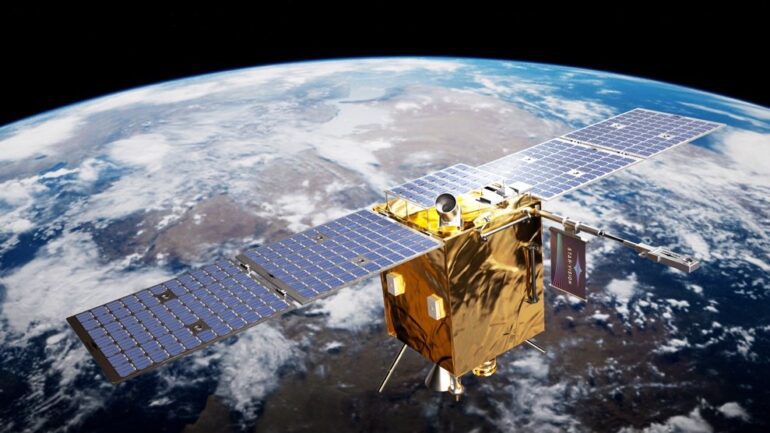TL;DR:
- Chinese company launches WonderJourney-1A (WJ-1A) satellite with integrated AI platform.
- String Edge AI Platform acts as satellite’s real-time processing brain, eliminating the need for ground control analysis.
- WJ-1A marks China’s first AI-driven satellite, showcasing an intelligent operating system.
- Satellite’s current focus is on system testing for diverse applications, from smart vehicles to ecological monitoring.
- Advanced imaging capabilities enable landscape recognition, target identification, and rapid data processing.
- “String” aspires to become an AI assistant in space, allowing human-like interaction.
- Real-time disaster alerts, environmental analysis, and emergency responses enhance the satellite’s potential.
- Onboard processing unit achieves 80 trillion operations per second, with plans to exceed 100 TOPS.
- STAR.VISION was awarded second place in MIT’s MultiEarth 2023 competition for innovative satellite remote sensing algorithms.
- Collaborative partnerships with Rwandan Space Agency and Sultan Qaboos University drive algorithmic development and AI talent.
- Expansion plans aim to deploy 20 satellites by 2024, amplifying coverage and communication efficacy.
Main AI News:
In a remarkable leap towards the future of space exploration, a pioneering Chinese enterprise has successfully propelled the WonderJourney-1A (WJ-1A) satellite, equipped with an unprecedented artificial intelligence (AI) infrastructure, into the cosmos. The momentous launch, orchestrated by the Jiuquan Satellite Launch Centre in Inner Mongolia, marks a decisive stride toward realizing the dream of an autonomous spacecraft.
The WJ-1A satellite is ingeniously fortified with the String Edge AI Platform, an ingenious onboard processing unit that empowers it with real-time cognitive capabilities. Traditionally, the exchange of data between satellites and ground control centers was a requisite for analysis and instructions. However, the WJ-1A stands apart, capable of swiftly processing information mid-flight. “String serves as the satellite’s brain, allowing real-time observation and processing,” articulated Chen Junrui, the spokesperson for STAR.VISION, the visionary Hangzhou-based firm behind this marvel.
WJ-1A ushers in a new era as China’s pioneering AI-fueled satellite boasts an intelligent operating system. Wang Chunhui, co-founder and chief technology officer of STAR.VISION, shared with Zhejiang Daily that the satellite is on the cusp of operational deployment. The nomenclature “WonderJourney” takes inspiration from the sagacious words of ancient Chinese philosopher Zhuangzi, who laid the conceptual foundation for the term “universe.” This name choice resonates with STAR.VISION’s aspiration is to propel AI into uncharted cosmic realms.
In its current phase, the satellite is dedicated to system testing, serving as a crucible for an array of intelligent applications destined to be evaluated for their orbital efficiency. These applications span from interfacing with future smart vehicles and drones to meticulously monitoring and assessing ecological parameters like forest fires, soil moisture, and pest infestations.
The WJ-1A’s robust suite of imaging technologies, encompassing high-resolution, near-infrared, and VR panoramic cameras, engenders multifaceted image processing capabilities. Through semantic image understanding, it discerns landscapes and oceans, while seamlessly engaging in target identification, lossless compression, and data refinement. Notably, the satellite outperforms its conventional counterparts by effortlessly analyzing a 10,000 square kilometer expanse within hours, a feat that typically takes traditional satellites half a year to achieve.
This AI-charged satellite maintains a continuous channel of communication with its terrestrial counterparts, with ongoing efforts to enhance its functional repertoire. Aptly named “String,” this onboard intelligence entity aspires to metamorphose into an “AI assistant in space.” Much like engaging with human-made AI entities, individuals on the ground will be able to converse with String, a convergence of technological progress and science fiction.
Chen envisages a novel learning curve for this celestial AI entity: “It’s like an untapped ‘brain,’ in order to make it smarter, more users from various industries are needed to teach it.” The ultimate goal is fostering human interaction with spacecraft, enabling the satellite to autonomously detect enigmatic situations unperceivable from Earth’s surface. This symbiotic exchange of knowledge propels the satellite to evolve ceaselessly without the need for inundating data transfers back to our planet.
The prospects of this technology reverberate beyond the cosmic expanse; it holds the potential to galvanize emergency responses. Real-time data processing empowers the satellite to expeditiously alert ground control to calamities like landslides, road collapses, or typhoon-ravaged zones. Moreover, it possesses the capability to scrutinize crop cultivation zones, detect water pollution, and combat illegal deforestation.
While its onboard processing unit currently attains a speed of 80 trillion operations per second (TOPS), slightly lower than Tesla’s Full-Self Driving chip, the WJ-1A is poised for further advancement. Overcoming the power constraints inherent to satellites, STAR.VISION anticipates its AI powerhouse to exceed 100 TOPS by year’s end.
An emblem of excellence, STAR.VISION’s efforts were celebrated with a second-place distinction in MIT’s Lincoln Laboratory-hosted MultiEarth 2023 competition. Their innovative algorithm harnessed satellite remote sensing to monitor Amazonian habitat degradation and climate shifts.
In a testament to international collaboration, STAR.VISION partners with institutions, including the Rwandan Space Agency and Oman’s Sultan Qaboos University. This alliance fuels a convergence of knowledge, fostering new horizons in applicable algorithms while nurturing AI talent.
As the celestial journey continues, STAR.VISION’s strategic blueprint charts the expansion of the WonderJourney constellation to encompass 20 satellites by 2024. These collective efforts promise amplified coverage and heightened communication efficiency, signaling an era where AI and space harmoniously converge to reshape the cosmos.
Conclusion:
The launch of the WonderJourney satellite represents a transformative stride at the intersection of AI and space exploration. This pioneering endeavor not only propels China’s position in the global space market but also heralds a new era where AI-driven satellites redefine our approach to communication, disaster response, and ecological monitoring. As STAR.VISION continues to push boundaries and collaborate with international partners, the market can anticipate an influx of AI-infused innovations that will reshape the very fabric of space technology and its practical applications.

